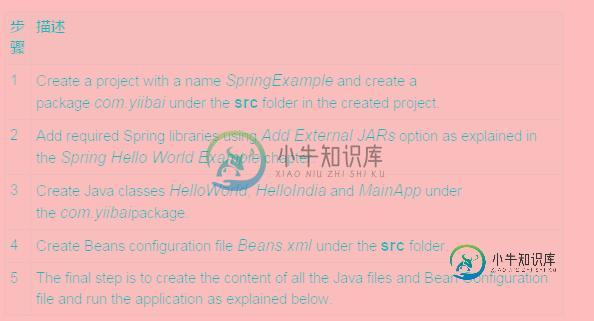Java的Spring框架中bean的继承与内部bean的注入
bean的定义继承
bean定义可以包含很多的配置信息,包括构造函数的参数,属性值,比如初始化方法,静态工厂方法名等容器的具体信息。
子bean定义从父定义继承配置数据。子的定义可以覆盖一些值,或者根据需要添加其他。
Spring bean定义继承无关,与Java类的继承,但继承的概念是一样的。你可以定义一个父bean定义为模板和其他孩子bean可以从父bean继承所需的配置。
当使用基于XML的配置元数据,指明一个子bean定义使用所在的当前属性指定的父bean作为这个属性的值。
例如:
让我们使用Eclipse IDE,然后按照下面的步骤来创建一个Spring应用程序:

以下是我们定义的“HelloWorld”豆里面有两个属性message1和message2配置文件beans.xml中。下一步“helloIndia”豆已经被定义为“HelloWorld”的子bean使用parent属性。该子bean继承message2属性原状,并覆盖message1 属性,并引入多一个属性message3。
<?xml version="1.0" encoding="UTF-8"?> <beans xmlns="http://www.springframework.org/schema/beans" xmlns:xsi="http://www.w3.org/2001/XMLSchema-instance" xsi:schemaLocation="http://www.springframework.org/schema/beans http://www.springframework.org/schema/beans/spring-beans-3.0.xsd"> <bean id="helloWorld" class="com.yiibai.HelloWorld"> <property name="message1" value="Hello World!"/> <property name="message2" value="Hello Second World!"/> </bean> <bean id="helloIndia" class="com.yiibai.HelloIndia" parent="helloWorld"> <property name="message1" value="Hello India!"/> <property name="message3" value="Namaste India!"/> </bean> </beans>
这里是HelloWorld.java 文件的内容:
package com.yiibai;
public class HelloWorld {
private String message1;
private String message2;
public void setMessage1(String message){
this.message1 = message;
}
public void setMessage2(String message){
this.message2 = message;
}
public void getMessage1(){
System.out.println("World Message1 : " + message1);
}
public void getMessage2(){
System.out.println("World Message2 : " + message2);
}
}
这里是HelloIndia.java文件的内容:
package com.yiibai;
public class HelloIndia {
private String message1;
private String message2;
private String message3;
public void setMessage1(String message){
this.message1 = message;
}
public void setMessage2(String message){
this.message2 = message;
}
public void setMessage3(String message){
this.message3 = message;
}
public void getMessage1(){
System.out.println("India Message1 : " + message1);
}
public void getMessage2(){
System.out.println("India Message2 : " + message2);
}
public void getMessage3(){
System.out.println("India Message3 : " + message3);
}
}
以下是MainApp.java文件的内容:
package com.yiibai;
import org.springframework.context.ApplicationContext;
import org.springframework.context.support.ClassPathXmlApplicationContext;
public class MainApp {
public static void main(String[] args) {
ApplicationContext context =
new ClassPathXmlApplicationContext("Beans.xml");
HelloWorld objA = (HelloWorld) context.getBean("helloWorld");
objA.getMessage1();
objA.getMessage2();
HelloIndia objB = (HelloIndia) context.getBean("helloIndia");
objB.getMessage1();
objB.getMessage2();
objB.getMessage3();
}
}
创建完成源代码和bean配置文件,让我们运行应用程序。如果一切顺利,这将打印以下信息:
World Message1 : Hello World! World Message2 : Hello Second World! India Message1 : Hello India! India Message2 : Hello Second World! India Message3 : Namaste India!
如果你在这里看到,我们没有通过message2同时创建“helloIndia”的bean,但它通过了,因为bean定义的继承。
bean定义模板:
您可以创建可以在不会花太多功夫被其他子bean定义的bean定义模板。在定义bean定义模板,不应指定类属性,并应与真值指定如下所示的抽象属性:
<?xml version="1.0" encoding="UTF-8"?> <beans xmlns="http://www.springframework.org/schema/beans" xmlns:xsi="http://www.w3.org/2001/XMLSchema-instance" xsi:schemaLocation="http://www.springframework.org/schema/beans http://www.springframework.org/schema/beans/spring-beans-3.0.xsd"> <bean id="beanTeamplate" abstract="true"> <property name="message1" value="Hello World!"/> <property name="message2" value="Hello Second World!"/> <property name="message3" value="Namaste India!"/> </bean> <bean id="helloIndia" class="com.yiibai.HelloIndia" parent="beanTeamplate"> <property name="message1" value="Hello India!"/> <property name="message3" value="Namaste India!"/> </bean> </beans>
父bean不能被实例化它自己,因为它是不完整的,而且它也明确地标记为抽象。当一个定义是抽象的这个样子,它只是作为一个纯粹的模板bean定义,充当子定义的父定义使用。
注入内部bean
正如你所知道的Java内部类是其他类的范围内定义的,同样,内部bean是被其他bean的范围内定义的bean。因此<property/>或<constructor-arg/>元素内<bean/>元件被称为内部bean和它如下所示。
<?xml version="1.0" encoding="UTF-8"?> <beans xmlns="http://www.springframework.org/schema/beans" xmlns:xsi="http://www.w3.org/2001/XMLSchema-instance" xsi:schemaLocation="http://www.springframework.org/schema/beans http://www.springframework.org/schema/beans/spring-beans-3.0.xsd"> <bean id="outerBean" class="..."> <property name="target"> <bean id="innerBean" class="..."/> </property> </bean> </beans>
例如:
我们使用Eclipse IDE,然后创建一个Spring应用程序,
这里是TextEditor.java文件的内容:
package com.yiibai;
public class TextEditor {
private SpellChecker spellChecker;
// a setter method to inject the dependency.
public void setSpellChecker(SpellChecker spellChecker) {
System.out.println("Inside setSpellChecker." );
this.spellChecker = spellChecker;
}
// a getter method to return spellChecker
public SpellChecker getSpellChecker() {
return spellChecker;
}
public void spellCheck() {
spellChecker.checkSpelling();
}
}
下面是另外一个相关的类文件SpellChecker.java内容:
package com.yiibai;
public class SpellChecker {
public SpellChecker(){
System.out.println("Inside SpellChecker constructor." );
}
public void checkSpelling(){
System.out.println("Inside checkSpelling." );
}
}
以下是MainApp.java文件的内容:
package com.yiibai;
import org.springframework.context.ApplicationContext;
import org.springframework.context.support.ClassPathXmlApplicationContext;
public class MainApp {
public static void main(String[] args) {
ApplicationContext context =
new ClassPathXmlApplicationContext("Beans.xml");
TextEditor te = (TextEditor) context.getBean("textEditor");
te.spellCheck();
}
}
以下是配置文件beans.xml文件里面有配置为基于setter 注入,但使用内部bean:
<?xml version="1.0" encoding="UTF-8"?> <beans xmlns="http://www.springframework.org/schema/beans" xmlns:xsi="http://www.w3.org/2001/XMLSchema-instance" xsi:schemaLocation="http://www.springframework.org/schema/beans http://www.springframework.org/schema/beans/spring-beans-3.0.xsd"> <!-- Definition for textEditor bean using inner bean --> <bean id="textEditor" class="com.yiibai.TextEditor"> <property name="spellChecker"> <bean id="spellChecker" class="com.yiibai.SpellChecker"/> </property> </bean> </beans>
创建源代码和bean配置文件来完成,让我们运行应用程序。如果一切顺利,这将打印以下信息:
Inside SpellChecker constructor. Inside setSpellChecker. Inside checkSpelling.
-
主要内容:示例 1,Bean 定义模板在 Spring 中,Bean 和 Bean 之间也存在继承关系。我们将被继承的 Bean 称为父 Bean,将继承父 Bean 配置信息的 Bean 称为子 Bean。 Spring Bean 的定义中可以包含很多配置信息,例如构造方法参数、属性值。子 Bean 既可以继承父 Bean 的配置数据,也可以根据需要重写或添加属于自己的配置信息。 在 Spring XML 配置中,我们通过子 Bea
-
本文向大家介绍详解Java的Spring框架中bean的注入集合,包括了详解Java的Spring框架中bean的注入集合的使用技巧和注意事项,需要的朋友参考一下 使用value属性和使用<property>标签的ref属性在你的bean配置文件中的对象引用,这两种情况下可以处理单值到一个bean,如果你想通过多元值,如Java Collection类型List, Set, Map 及 Prope
-
如何使用注释在Spring中提供bean继承?在XML配置中,我使用了
-
4.6. bean的继承 在bean定义中包含了大量的配置信息,其中包括容器相关的信息(比如初始化方法、静态工厂方法名等等)以及构造器参数和属性值。子bean定义就是从父bean定义继承配置数据的bean定义。它可以覆盖父bean的一些值,或者添加一些它需要的值。使用父/子bean定义的形式可以节省很多的输入工作。实际上,这就是一种模板形式。 当以编程的方式使用BeanFactory时,子bean
-
本文向大家介绍深入解析Java的Spring框架中bean的依赖注入,包括了深入解析Java的Spring框架中bean的依赖注入的使用技巧和注意事项,需要的朋友参考一下 每一个基于java的应用程序都有一个共同工作来展示给用户看到的内容作为工作的应用几个对象。当编写一个复杂的Java应用程序,应用程序类应该尽可能独立其他Java类来增加重复使用这些类,并独立于其他类别的测试它们,而这样做单元测试
-
问题内容: 使用基于注释的配置(等)是否可以实现相同的bean继承? http://docs.spring.io/spring/docs/4.1.0.BUILD-SNAPSHOT/spring-framework- reference/htmlsingle/#beans-child-bean- definitions 问题答案: java config中没有抽象bean的概念,因为Java语言已经

